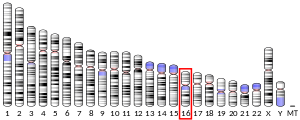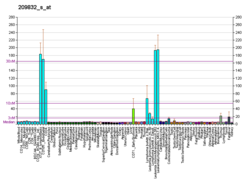CDT1 (Chromatin licensing and DNA replication factor 1) is a protein that in humans is encoded by the CDT1 gene.[5][6][7][8] It is a licensing factor that functions to limit DNA from replicating more than once per cell cycle.
Role in pre-replication complexes
editThe protein encoded by this gene is a key licensing factor in the assembly of pre-replication complexes (pre-RC), which occurs during the G1 phase of the cell cycle. In the assembly of pre-RCs, origin recognition complexes (ORC1-6) recognize and bind to DNA replication origins. CDT1, along with the protein CDC6, are then recruited to the forming pre-RC, followed by minichromosome maintenance complexes (MCM2-7).[9]
The activity of CDT1 during the cell cycle is tightly regulated during the S phase by the protein geminin, which inhibits it, and by SCFSKP2, which ubiquinates the protein to tag it for proteasomal degradation.[10] This regulation is important in preventing relicensing, thus ensuring that DNA is only replicated once per cell cycle.
Orthologs
editCDT1 belongs to a family of replication proteins conserved from yeast to humans. Examples of orthologs in other species include:
- S. pombe – CDT1 (CDC10-dependent transcript 1)[11]
- Drosophila melanogaster – 'double parked' or Dup[12]
- Xenopus laevis - CDT1[13]
Interactions
editDNA replication factor CDT1 has been shown to interact with SKP2.[14] Cdt1 is recruited by the origin recognition complex in origin licensing. Null-mutations for CDT1 are lethal in yeast; the spores undergo mitosis without DNA replication. The overexpression of CDT1 causes rereplication in H. sapiens, which activates the Chk1 pathway, preventing entry into mitosis.[15]
References
edit- ^ a b c GRCh38: Ensembl release 89: ENSG00000167513 – Ensembl, May 2017
- ^ a b c GRCm38: Ensembl release 89: ENSMUSG00000006585 – Ensembl, May 2017
- ^ "Human PubMed Reference:". National Center for Biotechnology Information, U.S. National Library of Medicine.
- ^ "Mouse PubMed Reference:". National Center for Biotechnology Information, U.S. National Library of Medicine.
- ^ Rialland M, Sola F, Santocanale C (March 2002). "Essential role of human CDT1 in DNA replication and chromatin licensing". J Cell Sci. 115 (Pt 7): 1435–40. doi:10.1242/jcs.115.7.1435. PMID 11896191.
- ^ Nishitani H, Taraviras S, Lygerou Z, Nishimoto T (November 2001). "The human licensing factor for DNA replication Cdt1 accumulates in G1 and is destabilized after initiation of S-phase". J Biol Chem. 276 (48): 44905–11. doi:10.1074/jbc.M105406200. PMID 11555648.
- ^ "Entrez Gene: CDT1 chromatin licensing and DNA replication factor 1".
- ^ "CDT1 gene". Genetics Home Reference. Retrieved 2018-07-19.
- ^ Hoffman, Ronald; Benz Jr., Edward J.; Silberstein, Leslie E.; Heslop, Helen; Weitz, Jeffrey I.; Anastasi, John; Salama, Mohamed E.; Abutalib, Syed A. (2018). Hematology : basic principles and practice. Hoffman, Ronald, 1945-, Benz, Edward J., Jr.,, Silberstein, Leslie E.,, Heslop, Helen,, Weitz, Jeffrey I.,, Anastasi, John (Seventh ed.). Philadelphia, PA. pp. Chapter 17, 176–185. ISBN 9780323509398. OCLC 1001961209.
{{cite book}}: CS1 maint: location missing publisher (link) - ^ Wohlschlegel JA, Dwyer BT, Dhar SK, Cvetic C, Walter JC, Dutta A (December 2000). "Inhibition of eukaryotic DNA replication by geminin binding to Cdt1". Science. 290 (5500): 2309–12. Bibcode:2000Sci...290.2309W. doi:10.1126/science.290.5500.2309. PMID 11125146.
- ^ Hofmann JF, Beach D (January 1994). "cdt1 is an essential target of the Cdc10/Sct1 transcription factor: requirement for DNA replication and inhibition of mitosis". EMBO J. 13 (2): 425–34. doi:10.1002/j.1460-2075.1994.tb06277.x. PMC 394824. PMID 8313888.
- ^ Nakajima H, Watanabe N, Shibata F, Kitamura T, Ikeda Y, Handa M (May 2006). "N-terminal region of CCAAT/enhancer-binding protein epsilon is critical for cell cycle arrest, apoptosis, and functional maturation during myeloid differentiation". J. Biol. Chem. 281 (20): 14494–502. doi:10.1074/jbc.M600575200. PMID 16531405.
- ^ Maiorano D, Moreau J, Méchali M (April 2000). "XCDT1 is required for the assembly of pre-replicative complexes in Xenopus laevis". Nature. 404 (6778): 622–5. Bibcode:2000Natur.404..622M. doi:10.1038/35007104. PMID 10766247. S2CID 4416138.
- ^ Li X, Zhao Q, Liao R, Sun P, Wu X (2003). "The SCF(Skp2) ubiquitin ligase complex interacts with the human replication licensing factor Cdt1 and regulates Cdt1 degradation". J. Biol. Chem. 278 (33): 30854–8. doi:10.1074/jbc.C300251200. PMID 12840033.
- ^ Machida YJ, Dutta A (2005). "Cellular checkpoint mechanisms monitoring proper initiation of DNA replication". J. Biol. Chem. 280 (8): 6253–6. doi:10.1074/jbc.R400037200. PMID 15591064.
Further reading
edit- Xouri G, Dimaki M, Bastiaens PI, Lygerou Z (2007). "Cdt1 interactions in the licensing process: a model for dynamic spatiotemporal control of licensing". Cell Cycle. 6 (13): 1549–52. doi:10.4161/cc.6.13.4455. PMID 17598984.
- Andersson B, Wentland MA, Ricafrente JY, et al. (1996). "A "double adaptor" method for improved shotgun library construction". Anal. Biochem. 236 (1): 107–13. doi:10.1006/abio.1996.0138. PMID 8619474.
- Yu W, Andersson B, Worley KC, et al. (1997). "Large-scale concatenation cDNA sequencing". Genome Res. 7 (4): 353–8. doi:10.1101/gr.7.4.353. PMC 139146. PMID 9110174.
- Nishitani H, Lygerou Z, Nishimoto T, Nurse P (2000). "The Cdt1 protein is required to license DNA for replication in fission yeast". Nature. 404 (6778): 625–8. Bibcode:2000Natur.404..625N. doi:10.1038/35007110. PMID 10766248. S2CID 205005540.
- Whittaker AJ, Royzman I, Orr-Weaver TL (2000). "Drosophila double parked: a conserved, essential replication protein that colocalizes with the origin recognition complex and links DNA replication with mitosis and the down-regulation of S phase transcripts". Genes Dev. 14 (14): 1765–76. doi:10.1101/gad.14.14.1765. PMC 316778. PMID 10898791.
- Wohlschlegel JA, Dwyer BT, Dhar SK, et al. (2001). "Inhibition of eukaryotic DNA replication by geminin binding to Cdt1". Science. 290 (5500): 2309–12. Bibcode:2000Sci...290.2309W. doi:10.1126/science.290.5500.2309. PMID 11125146.
- Yanagi K, Mizuno T, You Z, Hanaoka F (2002). "Mouse geminin inhibits not only Cdt1-MCM6 interactions but also a novel intrinsic Cdt1 DNA binding activity". J. Biol. Chem. 277 (43): 40871–80. doi:10.1074/jbc.M206202200. PMID 12192004.
- Bermejo R, Vilaboa N, Calés C (2003). "Regulation of CDC6, geminin, and CDT1 in human cells that undergo polyploidization". Mol. Biol. Cell. 13 (11): 3989–4000. doi:10.1091/mbc.E02-04-0217. PMC 133609. PMID 12429841.
- Strausberg RL, Feingold EA, Grouse LH, et al. (2003). "Generation and initial analysis of more than 15,000 full-length human and mouse cDNA sequences". Proc. Natl. Acad. Sci. U.S.A. 99 (26): 16899–903. Bibcode:2002PNAS...9916899M. doi:10.1073/pnas.242603899. PMC 139241. PMID 12477932.
- Li X, Zhao Q, Liao R, et al. (2003). "The SCF(Skp2) ubiquitin ligase complex interacts with the human replication licensing factor Cdt1 and regulates Cdt1 degradation". J. Biol. Chem. 278 (33): 30854–8. doi:10.1074/jbc.C300251200. PMID 12840033.
- Cook JG, Chasse DA, Nevins JR (2004). "The regulated association of Cdt1 with minichromosome maintenance proteins and Cdc6 in mammalian cells". J. Biol. Chem. 279 (10): 9625–33. doi:10.1074/jbc.M311933200. PMID 14672932.
- Sugimoto N, Tatsumi Y, Tsurumi T, et al. (2004). "Cdt1 phosphorylation by cyclin A-dependent kinases negatively regulates its function without affecting geminin binding". J. Biol. Chem. 279 (19): 19691–7. doi:10.1074/jbc.M313175200. PMID 14993212.
- Liu E, Li X, Yan F, et al. (2004). "Cyclin-dependent kinases phosphorylate human Cdt1 and induce its degradation". J. Biol. Chem. 279 (17): 17283–8. doi:10.1074/jbc.C300549200. PMID 15004027.
- Ramachandran N, Hainsworth E, Bhullar B, et al. (2004). "Self-assembling protein microarrays". Science. 305 (5680): 86–90. Bibcode:2004Sci...305...86R. doi:10.1126/science.1097639. PMID 15232106. S2CID 20936301.
- Ballabeni A, Melixetian M, Zamponi R, et al. (2005). "Human geminin promotes pre-RC formation and DNA replication by stabilizing CDT1 in mitosis". EMBO J. 23 (15): 3122–32. doi:10.1038/sj.emboj.7600314. PMC 514931. PMID 15257290.
- Saxena S, Yuan P, Dhar SK, et al. (2004). "A dimerized coiled-coil domain and an adjoining part of geminin interact with two sites on Cdt1 for replication inhibition". Mol. Cell. 15 (2): 245–58. doi:10.1016/j.molcel.2004.06.045. PMID 15260975.
- Kulartz M, Knippers R (2004). "The replicative regulator protein geminin on chromatin in the HeLa cell cycle". J. Biol. Chem. 279 (40): 41686–94. doi:10.1074/jbc.M405798200. PMID 15284237.
- Beausoleil SA, Jedrychowski M, Schwartz D, et al. (2004). "Large-scale characterization of HeLa cell nuclear phosphoproteins". Proc. Natl. Acad. Sci. U.S.A. 101 (33): 12130–5. Bibcode:2004PNAS..10112130B. doi:10.1073/pnas.0404720101. PMC 514446. PMID 15302935.
External links
edit- Overview of all the structural information available in the PDB for UniProt: Q9H211 (Human DNA replication factor Cdt1) at the PDBe-KB.
- Overview of all the structural information available in the PDB for UniProt: Q8R4E9 (Mouse DNA replication factor Cdt1) at the PDBe-KB.




